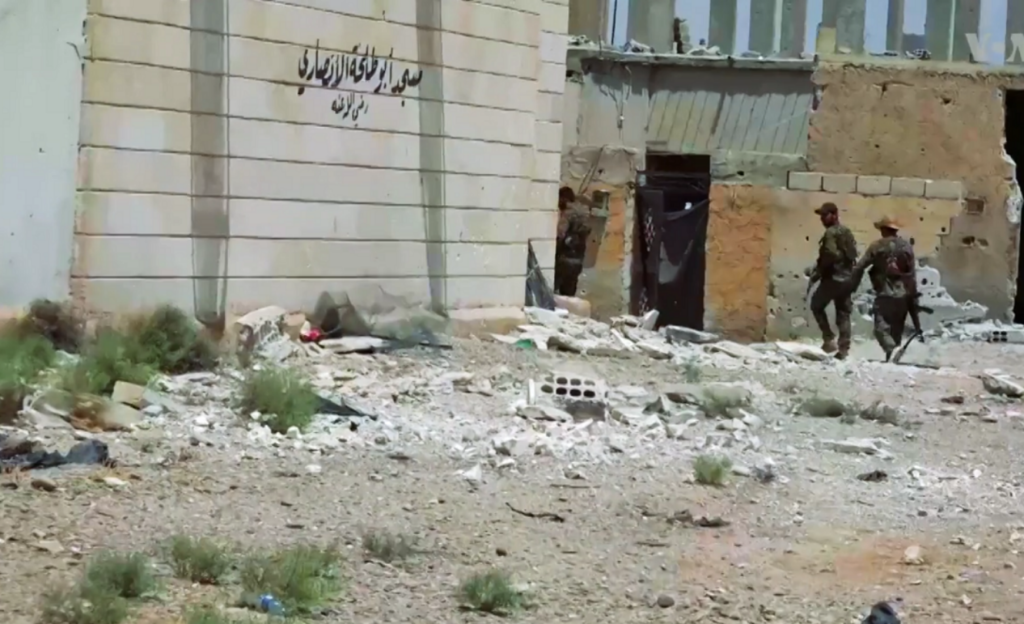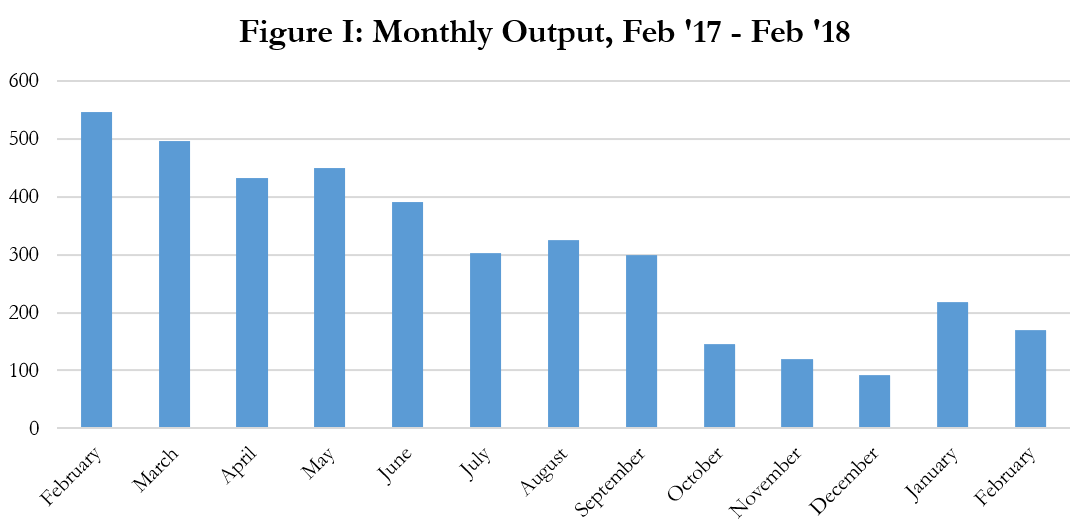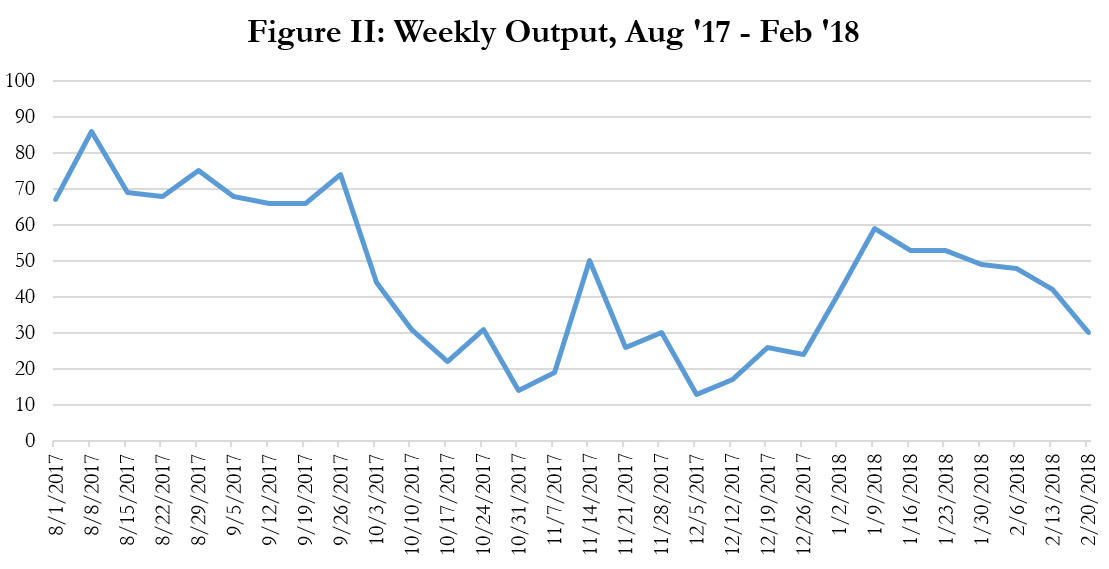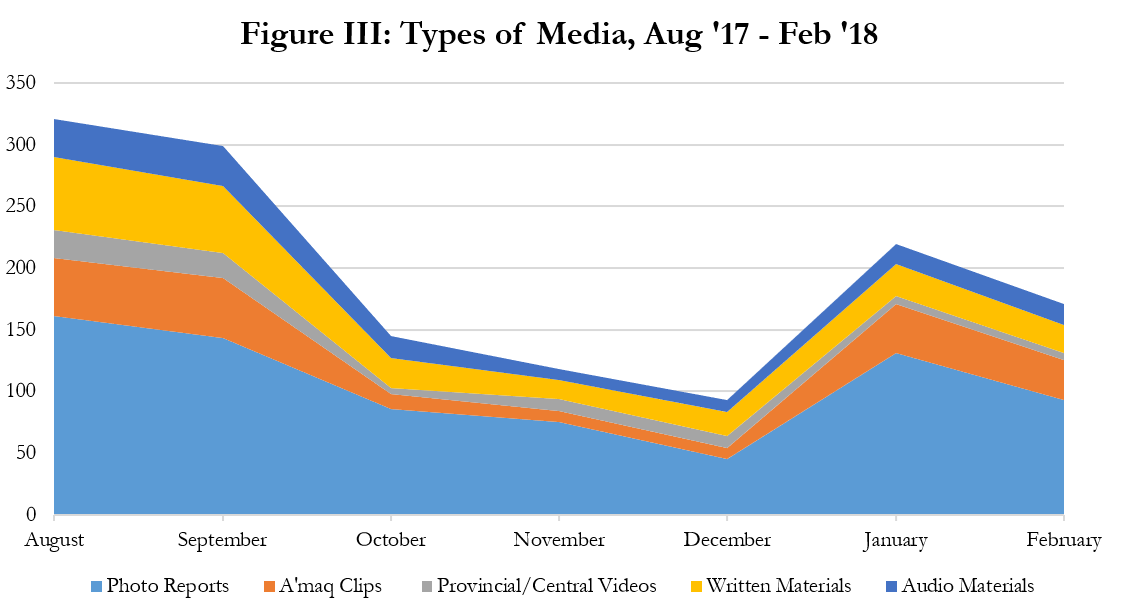Terror, Online and Off: Recent Trends in Islamic State Propaganda Operations

In 2015, when the Islamic State (ISIL) was at the peak of its propaganda activities, it had dozens of official outlets churning out hundreds of unique media products each week, framing its caliphate proto-state as a utopian alternative to the global status quo—a blissful place of stability, piety, and sunsets. However, as the years progressed and the coalition and its partners continued to advance in Syria and Iraq, its strategic communication operations altered course, becoming both less varied and less plentiful.
One of the first signs of their changing fortunes came in mid-2016, when the caliphate’s audio-visual capabilities temporarily dropped off a cliff online, its propaganda dissemination network on the Telegram app failing almost simultaneously. In the aftermath of this collapse, the group recovered, continuing to make propaganda (and lots of it) and adopting more resilient distribution tactics. Still, a new and less productive norm had emerged.
Fast forward two and a half years, and new data describe another such collapse, one even more pronounced than the last. Indeed, in the final three months of 2017, the Islamic State’s official online strategic communication capabilities were decimated. However, just as was the case in 2016, the collapse appears to have been impermanent, with output levels partially recovering in early 2018.
On the surface, the latest lull could be seen as a result of the group’s territorial decline in Iraq and Syria over the course of 2016 and 2017. However, the Islamic State’s operational priorities are more complex—and more flexible—than that.
This article puts the recent decline in ISIL propaganda into perspective, first by mapping it, and then by placing these trends into a broader strategic context and weighing their real-world policy implications. Our analysis looks beyond the virtual, arguing that an overly myopic focus on the Islamic State’s online propaganda effort – at the expense of understanding what the group is doing offline – risks hamstringing counter-insurgency and counter-terrorism efforts for years to come.
Mapping the Media Decline
Tracking the 2017 decline is no simple task. However, by examining ISIL’s output over the last year, paying special attention to the 1,373 unique media products that it published between Aug. 1, 2017, and Feb. 28, 2018, it is possible to reach some approximate conclusions about what has been happening in the organization’s media headquarters, and why.
Single “media products” may be central media office videos, like those of the AlHayat Media Center’s “Inside the Caliphate” series; provincial media office videos like Euphrates Province’s nostalgic vignette, “The Abode of Islam”; A’maq News Agency video clips, which tend to be shot crudely on battlefield GoPros; A’maq News Agency video reports, which are essentially formal news dispatches from the frontlines; or provincial media office photograph reports depicting anything from lettuce agriculture in Afghanistan to mortar training in northern Syria. Other examples include ISIL’s World War II-esque radio bulletins and readouts; ad hoc news articles describing operational successes; essays and pamphlets delving into the weeds of jihadist jurisprudence; electronic magazines inciting terrorism and reiterating the apocalyptic prophesies favoured by the Islamic State; weekly newspapers reaffirming the strategic narrative of inevitable triumph after defeat; audio statements from the likes of Abu Bakr al-Baghdadi; mobile apps promoting supplications and assigning prayer times; and, last but not least, religious songs sung a capella, otherwise known as anashid.
Each of these items was thus coded and counted individually in the database. Operation claims—2,375 of which were published between August 2017 and February 2018—were not included because they are customarily duplicated in other media products and, in any case, are not subject to the same editorial constraints or processes as photograph reports, radio bulletins, written materials, and videos. Furthermore, only official content was included in the count.

Considered in aggregate over the course of the last year, the data show that the Islamic State’s online productivity fell steadily by about five percent a month between February and September 2017 (see Figure I). From the end of September through December, though, the previously steady decline accelerated precipitously: By October, the group’s output levels had collapsed by more than 50 percent, falling by a further 17 percent in November, and 23 percent in December. In early 2018, it exhibited something of a recovery, with a 68 percent increase in productivity in the month of January that left its overall output not dissimilar to what it had been four months earlier. In February, though, online output once again dropped—albeit nowhere near as rapidly as had been the case in the fall and winter of 2017.

When examined on a week-by-week basis over the 30 weeks up to Feb. 28, 2018, as in Figure II, the data suggest that this end-of-year lull was prompted by something that occurred during the two weeks between Sept. 26 and Oct. 10. Given that it was Syria-related propaganda that fluctuated the most significantly (by far), the data also imply that this “something” took place in Syria.
The list of possible causes is, of course, endless, but it is likely that strategic advances in and around the Syrian cities of Raqqah, Mayadin, and al-Bu Kamal in the fall and winter of 2017 had something to do with it. Indeed, while the general decline dynamic is almost certainly a result of the Islamic State simply having fewer things to make propaganda about (as well as people to make it), this particular three-month depression was likely the result of something more immediate and more tactical, like the forced relocation of its central media hub. However, although this explanation is intuitive, the evidence is not conclusive.

The ‘Virtual Caliphate’ is Crumbling – But What About the Rest of It?
Even though it was impermanent, the damage caused by the recent media depression should not be dismissed out of hand. It is testament to the fact that the U.S.-led coalition and its partners came closer than they ever had before to silencing the Islamic State online—and for this, at least some credit is due.
The data imply that, at least in terms of online propaganda dissemination, the Islamic State’s “virtual caliphate” is feeling the heat. Based on the fact that its overall online decline over the last couple of years has been broadly consistent with losses on the ground, they also suggest a strong correlation between territorial clout and communication capability.
However, the trend is not as straightforward as it might appear. Indeed, fluctuations and micro-trends in the data are evidence of the strategic opportunism that has always characterised the Islamic State movement. For instance, the fact that the propaganda lulls were so often followed by surges suggests that the dips may not have been just a reaction, but in fact periods of semi-planned regrouping.
Consider, also, that quantity is not everything: In the aftermath of the 2016 collapse, for example, the Islamic State launched its new flagship magazine Rumiyah, and, right in the midst of its 2017 lull, it was able to release the second hyper-produced edition of its hour-long Flames of War film. The implication for practitioners is that tactical pressure breeds strategic innovation. When the Islamic State is at its lowest ebb, it also appears to be at its most creative.
Moreover, the jury is still out on the crucial issue of whether a decline in online propaganda capabilities is indicative of a concomitant decline in offline propaganda. It is not, and has never been, safe to assume that online trends are mirrored offline, and vice versa. No amount of big data analytics can provide insight into the offline side of the equation, in which ground level media operatives—whom the Islamic State celebrates as “martyrdom-seeker[s] without a belt”—lead the group’s in-theater communication endeavors.
The fact of the matter is that much, if not most, of the Islamic State’s propaganda is primarily designed and deployed for offline purposes. During recent field interviews in Marawi—a Filipino city just liberated from affiliates of the Islamic State—a consistent theme expressed to us by the local population was that the bulk of ISIL’s information assault was communicated via offline propaganda—e.g. face-to-face interactions and written materials like pamphlets and letters. Some citizens told us that Islamic State officials had visited their homes during the siege to explain the intent of their presence in the city, while a number of local Muslim clerics who had signed a fatwa condemning the group claimed to have received a series of personally addressed death threat letters. We heard similar descriptions of the dominance of offline propaganda methods at a local level when conducting interviews in 2015 and 2016 with activists living in parts of Syria and Iraq that were held by the Islamic State at the time.
To be sure, virtual capabilities have always had a role to play at the local level . In Marawi, for example, the Islamic State’s central propaganda units used material collected during the siege in their videos (e.g. the AlHayat Media Center’s Inside the Khilafah 3) and magazines (e.g. the tenth issue of Rumiyah). However, what was seen online was not indicative of the overall propaganda effort in the city and Mindanao Island more broadly, which locals insisted was dominated by interpersonal outreach.
This situation can be explained by two very practical considerations: First, chains of communication into (and through) local communities typically reflect offline social networks of family, clan, friends, and profession; and, second, unreliable connections mean that the Internet is not always the most effect communication medium. We hope to build on these initial findings during upcoming field interviews.
Conclusion
Something went wrong for the Islamic State at the end of 2017, something that knocked its propagandists off-kilter for more than three months. This is undeniably a good thing. However, we should be cautious in our optimism. Just as the Islamic State’s first media bust in the summer of 2016 did not spell the end of its influence operations, this latest episode should not be interpreted to suggest that the problem is anywhere near going away. Indeed, it testifies as much to the organization’s versatility as it does to its vulnerability.
Moreover, even if it did spell the end of the Islamic State’s online output, this would not solve the problem—far from it. Offline communication operations are more essential for the group’s survival than ever. It needs them to establish and strengthen local networks in regional communities; they are, in other words, the pillars upon which its future field operations will rest.
With this in mind, the extraordinary growth of research devoted to analyzing the Islamic State’s online propaganda output needs to be balanced by an increased focus on understanding the group’s offline messaging. Availability bias has reduced many observers to being blind men with the proverbial elephant in the room, assuming that the entirety of the problem lies before them just because it is what they have access to. This means that the group’s in-theater messaging strategies from West Africa to East Asia are at best misunderstood and at worst ignored.
But decisive victory in the war against the Islamic State requires strategic policy that takes into account both its online and offline activities. If policymakers continue to prioritise countering the Islamic State’s online communication operations at the expense of understanding and degrading their real-world manifestations, such complacency could result in a remobilized Islamic State in a matter of years. After all, this is an organization that has learned from previous spells of defeat that rising up again requires a granular focus; street by street at first, then town by town, and then province by province. So, while the Internet will certainly continue to be important for projecting and amplifying tactical victories to the world in the months and years to come, it is through offline communication operations that the Islamic State will look to win its strategic victories.
Charlie Winter is a senior research fellow at the International Centre for the Study of Radicalisation and PhD student at the Department of War Studies at King’s College London. Haroro J. Ingram is a senior research fellow at George Washington University’s Program on Extremism. Both authors are associate fellows at the International Centre for Counter-Terrorism in The Hague.
Image: Mahmoud Bali (VOA), Public domain, via Wikimedia Commons

